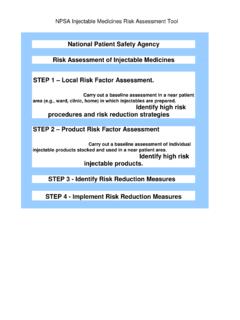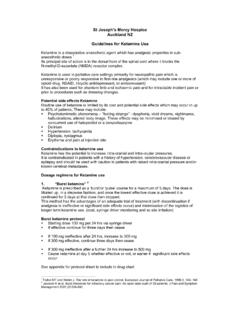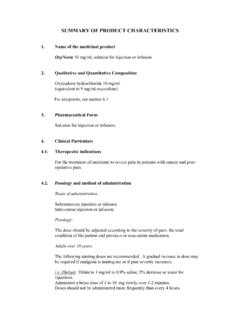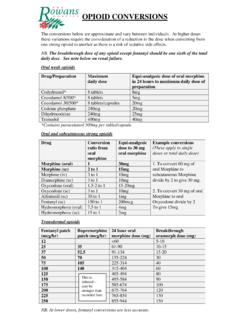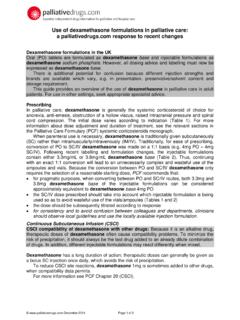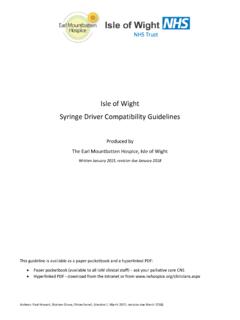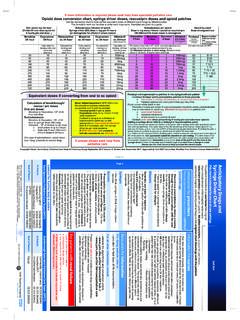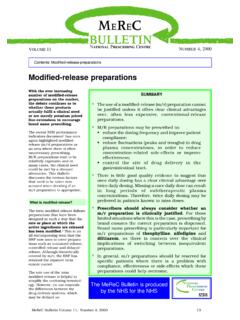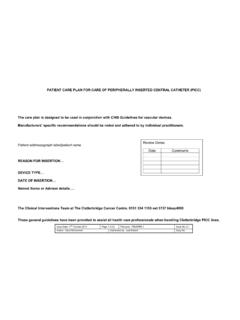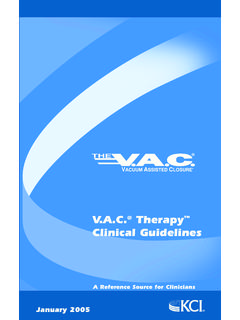Transcription of Subcutaneous hydration in palliative care v2.4 Final
1 Page 1 of 9 SPAGG Coversheet for Specialist palliative Audit and Guideline Group Agreed Documentation This sheet is to accompany all documentation agreed by SPAGG. This will assist maintenance of the guidelines as well as demonstrating the governance process undertaken prior to members seeking local approval in their areas of work. Document Title Guideline for the use of Subcutaneous hydration in palliative care Document Date September 2017 Document Purpose and Intended Audience To provide guidance to generalist/specialist healthcare professionals in the use of Subcutaneous hydration in palliative care Authors Dr (revised and updated original pan-birmingham cancer network document) References Please see document Consultation Process reviewed and updated Guidelines Subsequently reviewed and endorsed by SPAGG Review Date (must be within three years) September 2020 Page 2 of 9 Approval Signatures: SPAGG chair SPAGG deputy chair SPAGG secretary L.
2 Seager M. Turley and S Raynor Date Approved by SPAGG: 13 / 09 /2017 Date submitted to Area Prescribing Committee: Page 3 of 9 Guideline for the use of Subcutaneous hydration in palliative care Version History Version Date Summary of change/process 18/09/09 Amendments made following Governance Committee Sub Group Prepared for review by the NSSG in January 2012 Sent to John Speakman (lead author) by Rachel Loveless Sent to NSSG and SPAGG for comments (Marion Burns) Following consultation for review by TC With Final changes, for consideration by the Clinical Governance Sub Group Endorsed by the Governance Sub Group January 2017 Reviewed by Christina Radcliffe, Diana Webb and Jane Bartholomew on behalf of SPAGG March 2017 Circulated to SPAGG group for comments June 2017 Comments reviewed and updated August 2017 Final version produced, for ratification by SPAGG committee Date Approved by SPAGG Version September 2012 Version September 2017 Date for Review September 2020 Page 4 of 9 1 Scope of Guideline This guideline has been produced to support the administration of Subcutaneous fluids to palliative care patients in all care environments.
3 It has been produced to ensure consistent practice, use and equitable access to Subcutaneous fluids across the West Midlands region. 2 Guideline Background Subcutaneous hydration (previously known as hypodermoclysis) is a technique used for the Subcutaneous administration of large volumes of fluids and electrolytes in order to achieve fluid maintenance or replacement. It is used in patients who are unable to tolerate sufficient oral intake and where intravenous access may be difficult to obtain or sustain, or is inappropriate. Dying patients should be allowed and enabled to drink oral fluids where possible and good mouth care is key in the dying phase, whether or not a patient is receiving artificial hydration . The decision to commence artificial hydration in palliative care is made on an individualised basis, weighing up the potential risks and benefits and ensuring that the goals of treatment have been established with the patient and family and are reviewed regularly.
4 There may be specific societal, cultural and ethical implications of using Subcutaneous fluids. Where this involves complex decision making, the patient and family may benefit from referral to specialist palliative care teams. Solutions outlined in this guideline are only licensed for intravenous use therefore their use in this way is in an unlicensed procedure. However the effective use of infusion fluids in this way has been well documented. Guideline Statements 3 Patient Selection Indications for use a. Dehydration contributing to poor renal clearance of opioids which are causing symptoms of toxicity. b. Dehydration due to drowsiness due to reversible causes ( infection). c. Inability to swallow advanced head and neck tumour, unsuitable for gastrostomy or other artificial feeding tube. d. Symptoms due to dehydration that are not responding to other treatment ( intractable nausea or vomiting, severe dry mouth or thirst).
5 Page 5 of 9 e. To meet fluid requirements in the short term when oral intake is inadequate and maintaining an intravenous line is difficult or inappropriate. f. Strong patient (or carer where the patient lacks capacity) informed preference for artificial hydration where there are no contraindications. Confusion and restlessness can be occasionally aggravated by dehydration. However, quality evidence for use of Subcutaneous fluids in these patients is lacking. A short trial for the individual patient may be indicated to assess for benefit. There is insufficient evidence at present to indicate whether giving artificial hydration will extend life or prolong the dying process. Cautions/ contraindications a. Risk factors for fluid overload and existing ascites, heart failure or peripheral oedema due to hypoalbuminaemia. b. Severe renal or hepatic failure. c. Severe dehydration, shock or any condition requiring the rapid administration of fluids, in large volumes or when careful titration and monitoring of fluids is required (these patients should be given intravenous fluids).
6 D. Major bleeding or coagulation disorders. e. If the patient is imminently dying hydration will not improve survival or symptom management and may increase the risk of distressing respiratory secretions. f. For medication induced dry mouth. g. Patient refusal including applicable advanced decision to refuse treatment or lack of consent from an attorney named as lasting power of attorney for health and welfare. 4 Patient and carer information, and managing expectations For patients to give informed consent they should have a clear understanding of the following: a. the purpose of using Subcutaneous fluids b. that the underlying disease process will continue and that further deterioration may be due to this rather than reduced fluid intake c. how the decision will be made to stop the infusion (if appropriate) d. possible side effects of peri-tumour oedema, cerebral oedema, peripheral oedema, ascites and peripheral pooling of fluid causing swelling and discomfort e.
7 Possible side effects of increase in airway secretions causing a death rattle f. possible side effects of increase in gastrointestinal secretions causing increase in nausea and vomiting g. possible need for a urinary catheter Discussion with patients/carers around the use of a therapeutic trial of Subcutaneous fluids with defined outcome measures improvement in symptom control (ideally as reported by the patient) could be explored prior to administration of fluids. A discussion around artificial sense of hope should also be explored with the family. Page 6 of 9 5 Initiation and administration of the infusion Patients do not require routine referral to specialist palliative care teams solely due to commencing Subcutaneous fluids. However, there may be situations where this is helpful, including where decision making about fluid administration is complex, or where discussion occurs about transfer of a patient to an alternative care setting with Subcutaneous fluids in place.
8 Once referred, the Specialist palliative care team may be involved in the ongoing review of care for patients receiving Subcutaneous fluids. Administration of Subcutaneous fluids can be commenced by any registered nurse who is competent to administer Subcutaneous injections and insertion of a Subcutaneous needle. No formal training is required as the skills required to site a Subcutaneous needle and to care for an infusion set are covered in current syringe driver training. However, it is recognised that this may be a new area of practice for staff so individual organisations may wish to develop a competency framework for this intervention. The fluid of choice is sodium chloride or dextrose saline (glucose 4% and sodium chloride ), which can be given as an infusion or in boluses up to a maximum of 2 litres per 24 hour period (see below). Other fluids or medications should not be administered via this route.
9 Infusion Regimen Maximum continuous infusion rate: up to 100ml/hour Maximum infusion volume: usually two litres over 24 hours with a maximum of litres at any one site1,6 Maximum bolus dose: 500ml over one hour The infusion may be given: Continuously Overnight In boluses of 500ml per hour, two to three times each day with or without hyaluronidase The following equipment will be required: standard intravenous infusion set, for example solution set orange Y-site luer lock (Codan- 370001). NHS catalogue code FSC039 sodium chloride or dextrose saline (glucose 4% and sodium chloride ) one litre infusion bags hyaluronidase 1,500units ampoules drip stand cannula with a safety system (the use of Teflon or Vialon cannula instead of metal needles reduces insertion site complications and the need for frequent Page 7 of 9 needle changes) a clear adhesive dressing Appropriate skin cleansing apparatus label to date the intravenous infusion set The required consumables are all available from NHS supply chain Sodium Chloride and dextrose saline (glucose 4% and sodium chloride ) are classed as medicines and can therefore both be prescribed on FP10 prescription.
10 Where prescribers have difficulty locating this on an electronic system they can handwrite a prescription. Sodium Chloride and dextrose saline (glucose 4% and sodium chloride ) are available through all wholesalers in 500ml and 1000ml infusion bags, therefore, Community Pharmacies are able to supply both products. There may be a short delay whilst these are ordered. Please see the Specialist palliative care Drugs Supply Scheme for details of Pharmacies on the scheme who are commissioned to hold agreed fluids for infusion at all times. Community Pharmacies may claim broken bulk on supplies of individual bags for infusion made against a single prescription. When choosing the site for infusion placement the following should be considered: patient comfort and safety loose Subcutaneous tissue allows ease of larger volume of fluid whether the patient is mobile The abdomen, chest and lateral aspects of the upper arm or thigh are recommended sites.
